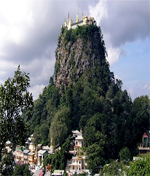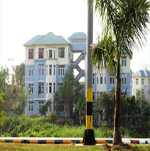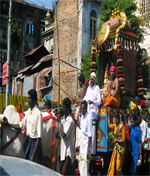
"Burma" is derived from the Burmese word "Bamar", which in turn is the colloquial form of Myanmar (or Mranma in old Burmese), both of which historically referred to the majority Burmans (or the Bamar). Depending on the register used the pronunciation would be "Bama", The name "Burma" has been in use in English since the time of British colonial rule.
Much of the country lies between the Tropic of Cancer and the Equator. It lies in the monsoon region of Asia, with its coastal regions receiving over 5,000 mm (196.9 in) of rain annually. Annual rainfall in the delta region is approximately 2,500 mm (98.4 in), while average annual rainfall in the Dry Zone, which is located in central Burma, is less than 1,000 mm (39.4 in).

Since 1992, the government has encouraged tourism in the country. However, fewer than 750,000 tourists enter the country annually.Burma's Minister of Hotels and Tourism Maj-Gen Saw Lwin has stated that the government receives a significant percentage of the income of private sector tourism services. Much of the country is completely off-limits to tourists, and the military very tightly controls interactions between foreigners and the people of Burma, particularly the border regions. They are not to discuss politics with foreigners, under penalty of imprisonment, and in 2001, the Myanmar Tourism Promotion Board issued an order for local officials to protect tourists and limit "unnecessary contact" between foreigners and ordinary Burmese people.

Burmese, the mother tongue of the Bamar and official language of Burma, is related to Tibetan and to the Chinese languages.[150] It is written in a script consisting of circular and semi-circular letters, which were adapted from the Mon script, which in turn was developed from a southern Indian script in the 8th century.
Many religions are practised in Burma. Religious edifices and orders have been in existence for many years. Festivals can be held on a grand scale. The Christian and Muslim populations do, however, face religious persecution and it is hard, if not impossible, for non-Buddhists to join the army or get government jobs, the main route to success in the country.

The educational system of Burma is operated by the government Ministry of Education. Universities and professional institutes from upper Burma and lower Burma are run by two separate entities, the Department of Higher Education of Upper Burma and the Department of Higher Education of Lower Burma. Headquarters are based in Yangon and Mandalay respectively.
There are 101 universities, 12 institutes, 9 degree colleges and 24 colleges in Burma, a total of 146 higher education institutions. There are 10 Technical Training Schools, 23 nursing training schools, 1 sport academy and 20 midwifery schools. There are 2047 Basic Education High Schools, 2605 Basic Education Middle Schools, 29944 Basic Education Primary Schools and 5952 Post Primary Schools. 1692 multimedia classrooms exist within this system.
Chitragupta Tours Pvt. Ltd
SH-8/3-A-I-K,
Shivpur Bypass
Behind Lord Budha Public School.
Shivpur, Varanasi-221003, (UP)-INDIA
![]() +91-9936188440, +91-9140245699
+91-9936188440, +91-9140245699
+91-9936188441
![]() info@chitraguptatours.in,
info@chitraguptatours.in,
![]() www.chitraguptatours.in
www.chitraguptatours.in